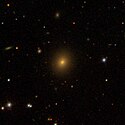IC 1806
| Galaxie IC 1806 | |
|---|---|
 | |
| AladinLite | |
| Sternbild | Widder |
| Position Äquinoktium: J2000.0, Epoche: J2000.0 | |
| Rektaszension | 02h 29m 34,9s[1] |
| Deklination | +22° 56′ 36″[1] |
| Erscheinungsbild | |
| Morphologischer Typ | E[1][2] |
| Helligkeit (visuell) | 15,1 mag[2] |
| Helligkeit (B-Band) | 16,1 mag[2] |
| Winkelausdehnung | 0,7′ × 0,5′[2] |
| Positionswinkel | 135°[2] |
| Flächenhelligkeit | 14,0 mag/arcmin²[2] |
| Physikalische Daten | |
| Rotverschiebung | 0.034050 ± 0.000067[1] |
| Radialgeschwindigkeit | 10.208 ± 20 km/s[1] |
| Hubbledistanz vrad / H0 | (460 ± 32) · 106 Lj (141,0 ± 9,9) Mpc [1] |
| Geschichte | |
| Entdeckung | Stéphane Javelle |
| Entdeckungsdatum | 16. Januar 1896 |
| Katalogbezeichnungen | |
| IC 1806 • PGC 95515 • 2MASX J02293494+2256351 • NVSS J022934+225638 • GIN 127 • LDCE 163 NED028 | |
IC 1806 ist eine elliptische Galaxie vom Hubble-Typ E3 im Sternbild Widder nördlich der Ekliptik. Sie ist schätzungsweise 460 Millionen Lichtjahre von der Milchstraße entfernt und hat einen Durchmesser von etwa 95.000 Lj.
Im selben Himmelsareal befinden sich u. a. die Galaxien IC 1802, IC 1804, IC 1807, IC 1809.
Das Objekt wurde am 16. Januar 1896 von Stéphane Javelle entdeckt.[3]
Weblinks
Einzelnachweise
Auf dieser Seite verwendete Medien
Autor/Urheber: Sloan Digital Sky Survey, Lizenz: CC BY 4.0
The sky image is obtained by Sloan Digital Sky Survey, DR14 with SciServer.
Angle of view: 4' × 4' (0.3" per pixel), north is up.
Details on the image processing pipeline: https://www.sdss.org/dr14/imaging/jpg-images-on-skyserver/



